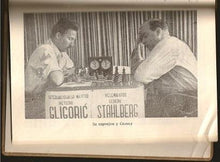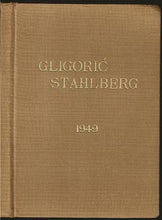Author: Gligoric, Svetozar (1923-2012) and Anders Gideon Tom Stahlberg
Year: 1949
Publisher: Sahovskog saveza Srbije
Place: Beograd (Belgrad)
Description:
109 pages with plates and diagrams. Duodecimo (6 1/2" x 3/4") bound in original publisher's brown cloth with gilt lettering to cover. (Biblioteca van Der Niemeijeriana: 5162) First edition.
The match of twelve games took place in May 1949 in Split and Belgrade, Yugoslavia. It was announced in January 1949 in the Swedish magazine Tidskrift for Schack. The match commenced on Friday, May 20th and ended on Thursday, June 9th, 1949. The match was keenly followed in Yugoslavia: "The public's interest was very great, the competition hall was filled to overflowing, and outside several hundred spectators followed its progress by way of the game's large demonstration boards. The Yugoslav Chess Federation showed the greatest hospitality, and the press devoted considerable space to the match. At the conclusion Gligoric as well as Stahlberg were acclaimed in lively fashion." The first eight games were played in Croatian port of Split, with the last four games played 530 kms away in the Serbian and Yugoslav capital Belgrade. This was match between Stahlberg an established grandmaster at his peak and ranked fifth in the world, and a rising star ranked 17. Stahlberg vied with Max Euwe in the late 1940's and early 1950's to be the pre-eminent grandmaster in Western Europe. His best results were in the decade after World War Two: Saltsjobaden Interzonal (1948) (6th, qualifying as a Candidate), the Budapest Candidates (1950) 1950 (7th of 10), Amsterdam (1950) (3rd out of 20), and the Stockholm Interzonal (1952) where he again qualified as a Candidate. Unfortunately, at the Zurich Candidates (1953) he came 15th and last. Gligoric at 26 year's old, was a rapidly rising star of Yugoslav chess. Gligoric had dominated the Yugoslav championship since the war (joint winner 1947, 1948, winner 1949). He was also coming to be recognized as a major force in international tournaments. In the strong tournaments in Warsaw 1947 (defeating Smyslov - Smyslov vs Gligoric, 1947) and in Budapest 1948, he came 1st and 2nd respectively. He shared 11th-13th places in Saltsjobaden Interzonal (1948). In the first post-war Olympiad, at Dubrovnik 1950, Gligoric played top board for the Yugoslavian team which was to win the gold medal. After this match, Gligoric continued to progress becoming an International Master in 1950 (although a photograph of the players in the match book clearly shows a sign with "International Master" against his name) and a Grandmaster in 1951. This was a real achievement at a time when international opportunities were scare and titled players few in number. The openings were those heavily used in the 1930's. Although Gligoric became one of the leading contributors to the Kings Indian Defense. Gligoric chose games 8 and 9 for inclusion his best games collection of 1952, 100 partija Svetozara Gligoricca. Ståhlberg was recognised as a leading expert on the French Defence and used it the three times. Gligoric was White in the odd numbered games. It was a closely fought contest which was tied at one win each until Game 8 when Gligoric pulled ahead and remained so until the end of the 12 game match.
Condition:
Corners bumped, cover slightly warped else about very good.
SOLD 2023





